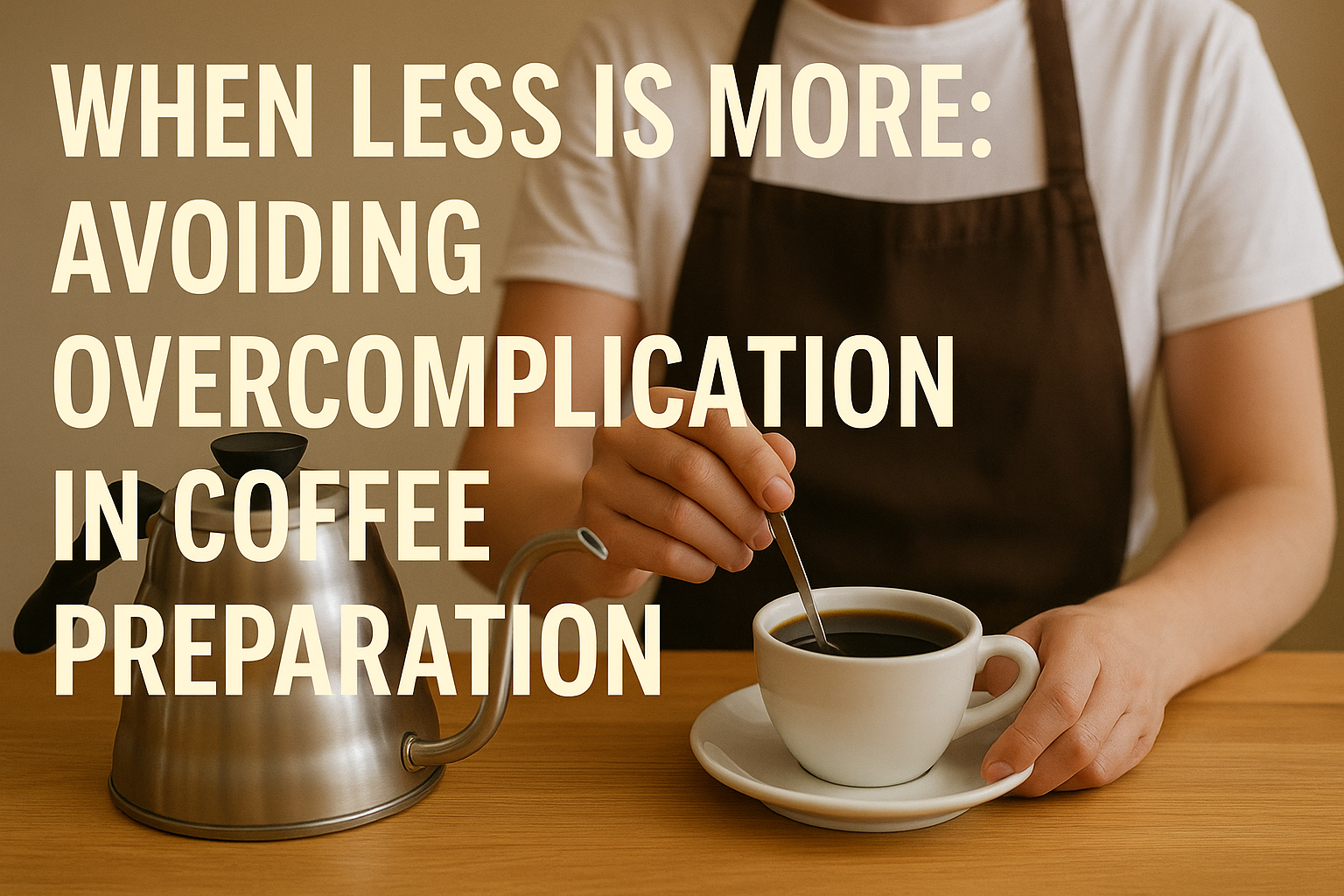As a beginner barista, it’s easy to think that impressing customers means making complex drinks, using exotic ingredients, or performing flashy techniques. But in reality, the best baristas know when to keep it simple.
Overcomplicating coffee preparation is a mistake many new baristas make. Whether it’s adding too many steps to a recipe, experimenting without understanding the basics, or cluttering the station with tools you don’t need — more isn’t always better.
In fact, in most cafés, simplicity equals consistency, and consistency is what keeps customers coming back.
This article will help you recognize when you’re doing too much — and how to focus on doing the right things well.
Why Simplicity Matters in Coffee
Coffee isn’t about showing off. It’s about delivering quality in every cup, especially during busy shifts. That means being fast, clean, and accurate.
Simplicity helps you:
- Stay consistent with flavor and presentation
- Work faster and more efficiently
- Make fewer mistakes under pressure
- Create drinks customers can enjoy — and remember
- Keep your station clean and organized
In other words: simplicity builds trust — with your team, your manager, and your customers.
Mistake #1: Using Too Many Ingredients
New baristas sometimes try to stand out by adding flavored syrups, spices, whipped cream, and decorative toppings — all in the same drink.
Why it’s a problem:
- The flavors clash and confuse the palate
- It slows down your workflow
- It makes the drink harder to reproduce
- It distracts from the coffee itself
What to do instead:
- Focus on balance, not quantity
- Let the coffee be the star
- Use high-quality ingredients in small doses
- Follow the café’s recipes before inventing your own
Start with the basics. Creativity comes later — after you’ve mastered control.
Mistake #2: Over-Steaming the Milk “Just in Case”
Baristas often steam more milk than they need, thinking it’s safer to have extra than to run short. The result? Waste, poor texture, and time lost.
Why this backfires:
- Milk loses texture quickly if it sits
- Re-steaming is never acceptable (and unsafe)
- You’ll struggle to pour with control in a half-full pitcher
- Your café will waste product — and notice
What to do instead:
- Estimate the correct amount based on cup size
- Practice visual measurement in your pitcher
- If in doubt, ask for advice or measure your milk until it becomes second nature
Efficiency isn’t just faster — it’s smarter.
Mistake #3: Overthinking Every Step
Beginner baristas often get stuck in their heads. They overanalyze every step — how much to tamp, how long to steam, how to hold the jug — and this hesitation slows them down and creates stress.
Signs of overthinking:
- You freeze during rushes
- You take too long between steps
- You worry more about perfection than progress
How to fix it:
- Trust your training and muscle memory
- Focus on one skill at a time, not everything at once
- Accept that mistakes are part of the learning process
- Ask for feedback, but don’t try to change everything at once
You’ll grow faster by doing things consistently — not perfectly.
Mistake #4: Trying to Make Every Drink an Art Project
Latte art is beautiful, and practicing it is encouraged — but when you try to pour advanced designs into every drink, even during busy times, it can slow you down and frustrate your team.
What this creates:
- Long wait times
- Wasted drinks due to failed pours
- Stress and pressure that affects quality
Better approach:
- Practice art during slow hours or off-shift
- Use rushes to focus on speed and texture
- Let the drink taste great first — the design is secondary
- Ask your manager when it’s okay to experiment
There’s a time and place for art — but during service, flavor and flow come first.
Mistake #5: Cluttering Your Workspace with Tools You Don’t Need
Baristas love gear — tampers, levelers, milk pitchers of every size, shot timers, scales, WDT tools, and more. While some tools are helpful, too many can clutter your station and slow you down.
Why this matters:
- You waste time looking for what you need
- Other baristas can’t share the space easily
- Your flow gets interrupted
- It makes you look disorganized
What to do:
- Keep only the essential tools at your bar spot
- Clean as you go
- Store personal tools neatly when not in use
- Ask your manager what’s allowed or preferred during shifts
A clean station is a fast station.
Mistake #6: Changing Recipes Without Permission
You might see a TikTok version of a mocha that looks better. Or maybe you think your own recipe tastes sweeter. But changing recipes without approval is a big no-no in most cafés.
Why it causes problems:
- Customers expect consistency — especially regulars
- Your coworkers won’t know what you did
- It creates confusion during quality checks
- It’s disrespectful to the café’s brand
What to do:
- Follow the house recipes exactly
- If you have a creative idea, pitch it to your manager
- Test your version off-shift and ask for feedback
- Learn the rules before you bend them
Creativity is welcome — but professionalism comes first.
Mistake #7: Making Too Many Adjustments at Once
You changed your grind, tamped differently, used a new dose, and tried a different milk. Now your drink tastes… off. But you don’t know which change caused it.
This makes it hard to learn:
- You can’t troubleshoot errors
- You can’t repeat success
- You confuse your own progress
What to do instead:
- Change one variable at a time
- Observe the result, then adjust again
- Keep notes if needed — it’s how pros learn to dial in
- Ask senior baristas to taste and explain what’s happening
Keep it simple, and your learning curve will speed up.
Mistake #8: Over-Talking While Making Drinks
Being friendly is part of the job — but talking too much while prepping drinks can distract you and slow you down.
Examples:
- Telling a long story while steaming milk
- Missing a shot time because you’re chatting
- Forgetting a drink modifier because you were distracted
Tip:
- Greet warmly, then focus on the drink
- Once the drink is done, hand it off with a smile and a few words
- If the café is quiet, engage more — if it’s busy, keep it brief
Great service is about presence, not just conversation.
Simplicity Is a Skill — Not a Lack of Skill
Some people think simple baristas are lazy or uncreative. But in truth, the best baristas make things look easy because they’ve practiced the fundamentals so well that they don’t need to do extra.
Simple means:
- You’re confident
- You know what matters
- You’ve stripped away distractions
- You care about consistency, speed, and quality
Simplicity is not boring — it’s mastery.
Final Thoughts: Master the Basics Before You Add More
You don’t need to impress anyone with complicated drinks, over-decorated lattes, or expensive tools. You impress people by being fast, clean, consistent, and professional — every single time.
So if you’re ever unsure, remember:
Less is more. Simpler is smarter. Better is better.
Start with the fundamentals. Build your habits. Learn the rules. Then, over time, you’ll earn the freedom to get creative — and when you do, it’ll actually matter.

Marcelo Rodrigues is a passionate barista with over 7 years of experience in specialty coffee. He’s worked in top cafés, led barista training sessions, and now shares practical tips to help beginners and coffee lovers improve their skills. Through this blog, Marcel makes the world of coffee more accessible—one cup at a time.

